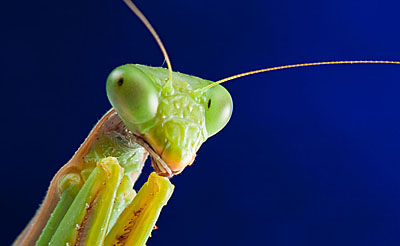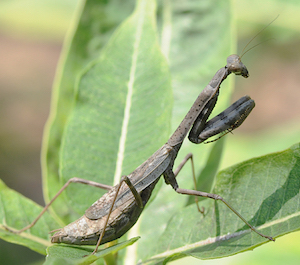Friend or Foe
Praying Mantis
By Jan Marie Pickrel, Fairfax Master Gardener Intern
 The creature looked the miniature star of a space alien horror movie. Its triangle-shaped head consisted of two large eyes and a mouth, perilously perched atop a long neck and smoothly-arched body, whose rear legs effortlessly clung to the screen of my sliding glass door. One of its front arms grasped a black ant. With its free front arm, the alien plucked a single leg from the ant and held the leg closer to one eye to examine it. It nonchalantly took a small nibble of the separated leg and turned its head 180degrees to scan the setting sun while the now five-legged ant continued to wriggle and writhe.
The creature looked the miniature star of a space alien horror movie. Its triangle-shaped head consisted of two large eyes and a mouth, perilously perched atop a long neck and smoothly-arched body, whose rear legs effortlessly clung to the screen of my sliding glass door. One of its front arms grasped a black ant. With its free front arm, the alien plucked a single leg from the ant and held the leg closer to one eye to examine it. It nonchalantly took a small nibble of the separated leg and turned its head 180degrees to scan the setting sun while the now five-legged ant continued to wriggle and writhe.
This 2-inch-long, brown, Carolina mantid (Stagmomantis carolina) is the native praying mantis species commonly seen in US Mid-Atlantic gardens. Two larger cousins that are common in Virginia were introduced to the United States in the early 20th century, the European mantid (Mantis religiosa) and Chinese mantid (Tenodera aridifolia sinensis). After getting their adult wings, they can reach 5 inches long and be either brown or green, their coloring variable for camouflage. We typically regret introducing non-native species into an area, particularly ones larger than our native species. They may invade an area and over-prey on the insects that we did not intend for them to “control.” Is the praying mantis in this same category?

Carolina mantis
What about the reputation of the female mantid as a “man-eater” who eats its mate as an appetizer, main course, or dessert? Some studies now question if this mate-devouring, passionate practice that has been observed in the laboratory regularly happens in the natural garden. Regardless, frosts of autumn and freezing winter temperatures kill any remaining adults, while their progeny await the warmth of spring in their oval-shaped, Styrofoam-looking egg case, emerging as nymphs when temperatures again reach approximately 70 degrees in the spring.
So: is the prehistoric or alien-looking praying mantis, native and non-native species, a friend or foe in our gardens? Although its eating habits may not allow it to act as the prime source of pest control in the garden, its diet places the mantid at the top of the insect food chain. Its presence is a sign of healthy garden diversity. Human chemical pesticide is its primary foe.
References
• ENTFACT-418: Praying Mantids, by Gary Watkins and Ric Bessin, University of Kentucky Entomology,
University of Kentucky College of Agriculture
• Beneficials in the Garden: Praying Mantis, Betty Gray , Galveston County Master Gardeners
• Predators — Praying Mantid (Mantis), University of Maryland
• Praying Mantis, Iowa State University, Extension and Outreach, Horticulture and Home Pest News
• Praying Mantis, Field Guide to Common Texas Insects, Texas A&M Agrilife Extension